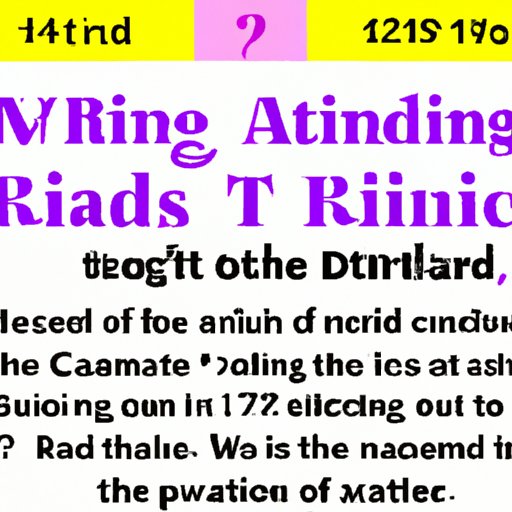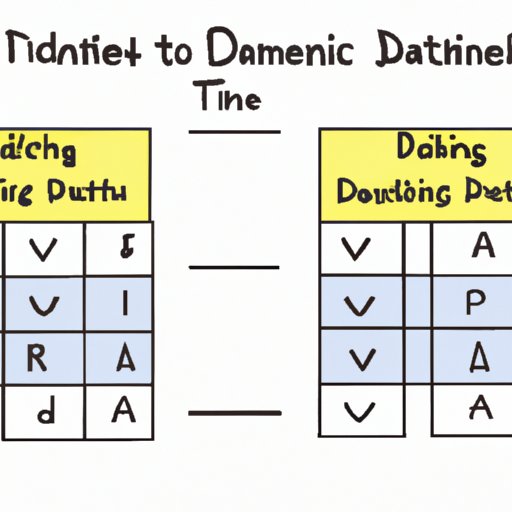Introduction
Radiometric dating, also known as radioactive dating, is a method of determining the age of an object by measuring the amount of radioactive isotopes present in it. It is one of the most accurate and reliable methods for measuring the age of objects and has been used extensively since its development in the early 20th century. Radiometric dating is important for understanding the history of the Earth and for establishing the ages of different geological events.

Explaining the Basics of Radiometric Dating
In order to understand radiometric dating, it is important to first understand radioactivity. Radioactivity occurs when an atom becomes unstable and releases energy in the form of radiation. This radiation can be used to measure the age of an object by measuring the amount of radioactive isotopes present.
Radiometric dating works by measuring the ratio of two isotopes of the same element, usually uranium or potassium. By comparing the ratio of the two isotopes in a sample, scientists can calculate the age of the sample. The process of radiometric dating is relatively simple. First, the amount of radioactive isotopes in the sample are measured. Then, the rate of decay of each isotope is determined and the ratio of the two isotopes is calculated. Finally, the age of the sample is determined based on the ratio of the two isotopes.
There are several different types of radiometric dating that are used to determine the age of objects. These include carbon-14 dating, uranium-lead dating, and potassium-argon dating. Each type of radiometric dating has its own unique characteristics and is used for different types of materials.

Breaking Down the Science Behind Radiometric Dating
In order to understand how radiometric dating works, it is important to understand the process of radioactive decay. Radioactive decay is a process in which unstable atoms lose energy and become stable. This process occurs at a constant rate, known as the half-life, and is used to measure the age of an object.
The half-life of a particular element is the amount of time it takes for half of the atoms in a sample to decay. Knowing the half-life of an element allows scientists to measure the age of a sample by measuring the amount of the element present in the sample. For example, if a sample contains 10% of the original isotope, then it can be estimated to be approximately 5 half-lives old.
In addition to measuring the amount of the element present in a sample, scientists must also measure the amount of the other isotope in the sample. This is done by measuring the ratio of the two isotopes in the sample. Once this ratio is known, the age of the sample can be determined.

Examining the Different Types of Radiometric Dating
Carbon-14 dating is one of the most common types of radiometric dating. Carbon-14 is a radioactive isotope of carbon that is present in all living organisms. When an organism dies, the amount of carbon-14 begins to decrease as it decays into nitrogen. By measuring the amount of carbon-14 in a sample, scientists can estimate the age of the sample.
Uranium-lead dating is another type of radiometric dating. This type of dating involves measuring the amount of uranium and lead in a sample. Uranium-lead dating is used to measure the age of rocks and fossils, as well as to determine the age of meteorites.
Potassium-argon dating is another type of radiometric dating. In this type of dating, scientists measure the amount of potassium and argon in a sample. Potassium-argon dating is used to measure the age of volcanic rocks and minerals. It is also used to date archaeological artifacts such as pottery and stone tools.
Describing the Accuracy of Radiometric Dating
Radiometric dating is considered to be a very accurate method for determining the age of an object. However, there are some limitations to this method. One limitation is that samples must be carefully collected and stored in order to prevent contamination. Additionally, the half-life of certain elements may not be known precisely, which can lead to inaccurate results.
Despite these limitations, radiometric dating is still considered to be one of the most accurate methods for measuring the age of an object. The accuracy of radiometric dating is dependent upon the type of material being dated, as well as the accuracy of the equipment used to measure the amount of radioactive isotopes in the sample.
Investigating How Radiometric Dating is Used in Geology
Radiometric dating is an important tool in geology. It is used to date rocks and fossils, as well as to determine the age of geological events. Radiometric dating can be used to date sedimentary rocks, metamorphic rocks, and igneous rocks. It can also be used to date fossils, which are preserved remains of animals or plants.
Radiometric dating is also used to determine the age of archaeological artifacts, such as pottery and stone tools. This method is especially useful for determining the age of artifacts that cannot be easily dated using other methods.
Analysing the Pros and Cons of Radiometric Dating
Radiometric dating has both advantages and disadvantages. One advantage is that it is a very accurate method for determining the age of an object. Additionally, it is relatively easy to use, and does not require any special equipment. However, one disadvantage is that it is limited to dating objects that contain radioactive isotopes. Additionally, there is always the possibility of contamination, which can lead to inaccurate results.

Comparing Radiometric Dating to Other Dating Methods
Radiometric dating is often compared to relative dating, which is a method of determining the age of an object based on its position in relation to other objects. Relative dating is less accurate than radiometric dating, as it does not take into account the amount of radioactive isotopes present in a sample. Additionally, relative dating can only be used to accurately date objects that are close in age.
Radiometric dating has several benefits over other dating methods. It is more accurate than relative dating, as it takes into account the amount of radioactive isotopes in the sample. Additionally, it is able to accurately date objects of any age. Furthermore, it does not require any special equipment and is relatively easy to use.
Conclusion
Radiometric dating is an important and reliable tool for measuring the age of objects. It is accurate, easy to use, and does not require any special equipment. Radiometric dating has been used for decades to accurately measure the age of rocks and fossils, as well as to determine the age of geological events. It is an invaluable tool in geology and archaeology, and is essential for understanding the history of the Earth.
(Note: Is this article not meeting your expectations? Do you have knowledge or insights to share? Unlock new opportunities and expand your reach by joining our authors team. Click Registration to join us and share your expertise with our readers.)
